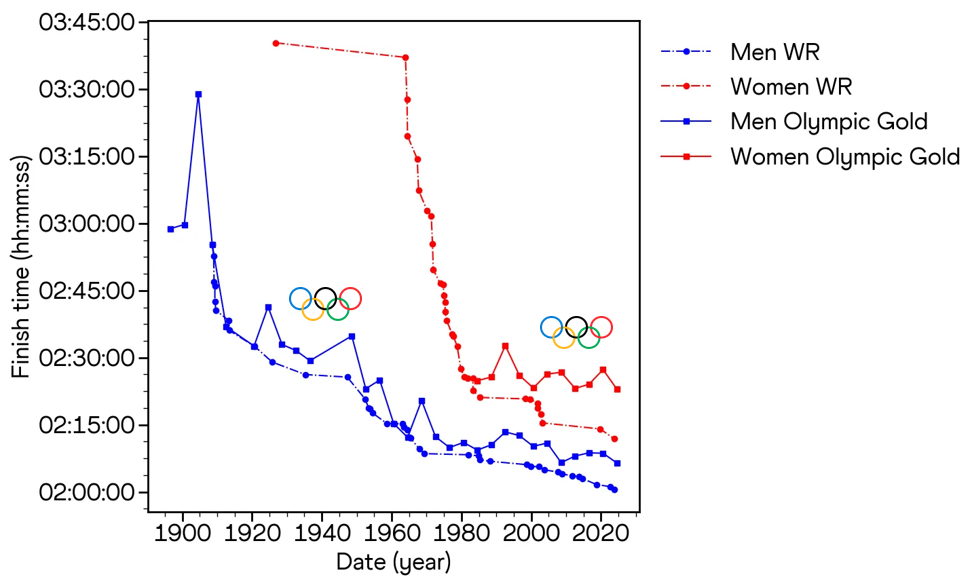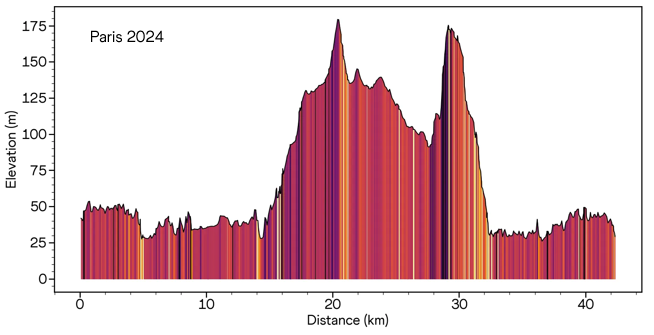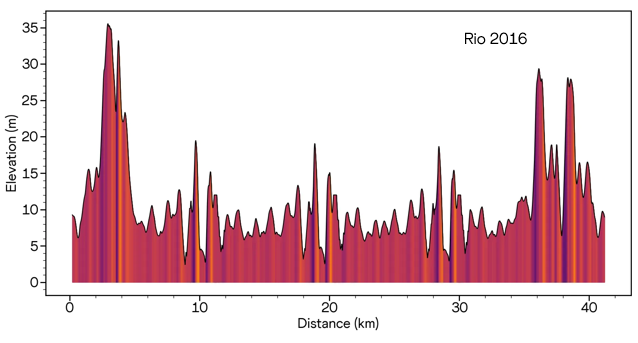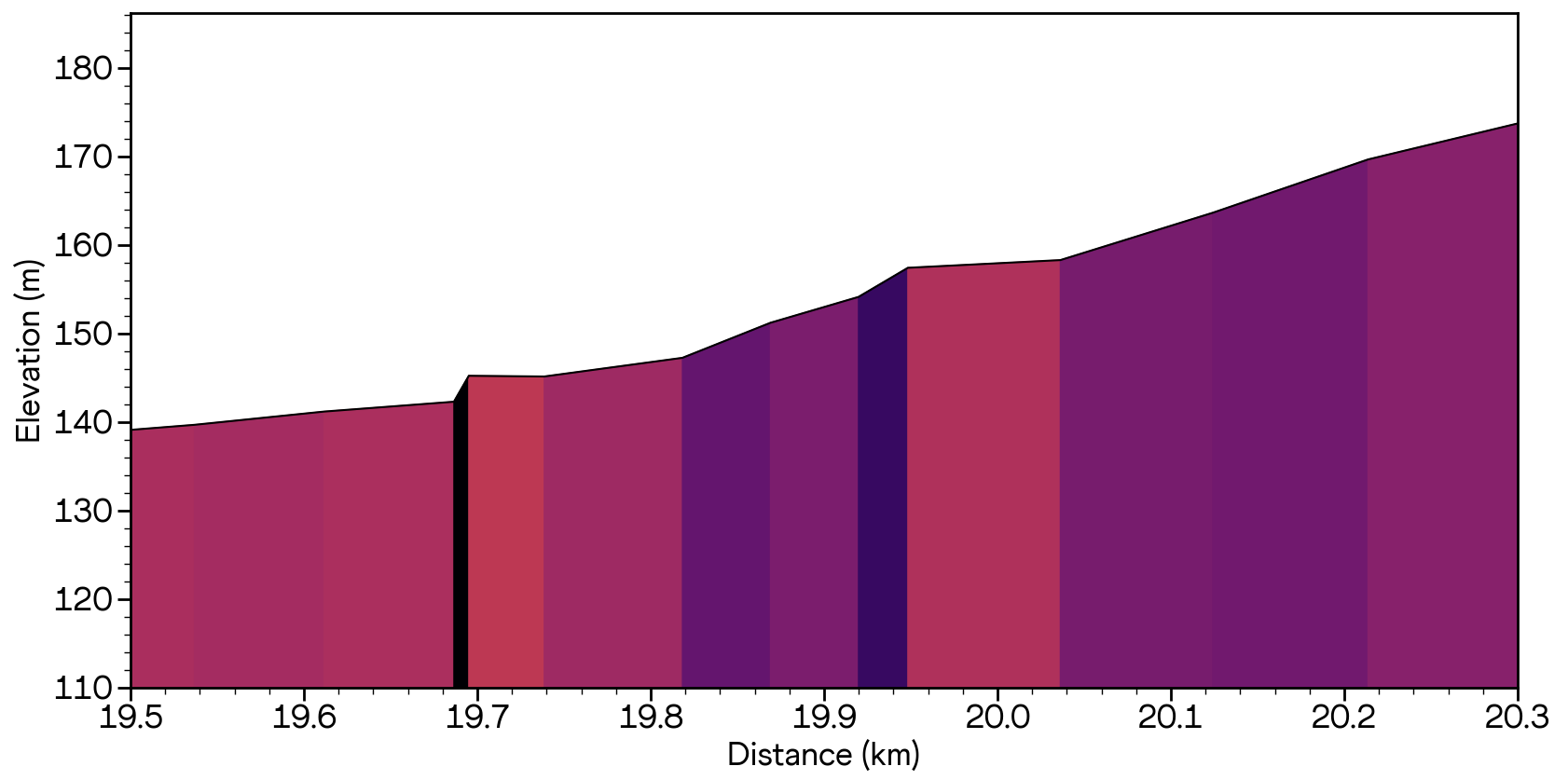Tamirat Tola wins the marathon at the Paris 2024 Olympic Games (© Christel Saneh for World Athletics )
Breaking Tiki Gelana’s London 2012 record by 12 seconds, it is Siffan Hassan who took the upper hand over Tigist Assefa, the world record holder, in the final hundred meters with a finish time of 2h 22 min 55s. In the men’s race, Tamirat Tola, running solo from the 28th kilometer to the end, broke the Olympic Record with a time of 2h 06 min and 26s, 6 seconds faster than Kenyan Samuel Wanjiru in Beijing 2008.
This month, World Academy guest contributors Anthony Saliou and Joseph Mestrallet put the Olympic marathon under the microscope. These two data scientists from Enduraw passionate about endurance sports and mathematics, will reveal the hidden aspects of top-level sport and share their analysis in a series of 3 articles.
Over the last decades and in the modern era of Olympics, there has been a continuous trend of record-breaking. However, Olympic marathons are known for their strategic nature rather than absolute speed. The last men’s Olympic marathon where a World Record was set took place in Antwerp in 1920. The history of women’s events began later, in Los Angeles 1984, and all marathons since have been won at a slower pace than the previous world record pace.

Figure: Evolution of World Records and Olympic event winning times through the years. Naturally, records decrease over time. However, Olympic times do not always follow this pattern, as they often correspond to tactical races.
While world records have improved, Olympic events are not always won at a very fast pace. Similar to championship events, these marathons are usually tactical races, where athletes aim to finish first, rather than achieve the fastest time. Nonetheless, with scientific advances, many parameters such as training methodologies, nutrition, shoes, and clothing have been optimized to improve athletes’ performances, resulting in records being broken in succession. Consequently, even if time is not the primary focus of Olympic races, they increasingly demand speed capabilities, as shown by qualifying standards set at 2h26min 50s for women and 2h8min10s for men.
The Paris 2024 Olympic marathon was not among the fastest marathons in history. This is typical for Olympic marathons. Nevertheless, athletes’ performances in the latest Summer Olympics defied all expectations. While the course profile was expected to significantly impact times, other factors worked in the opposite direction: advancements in footwear, lower-than-expected temperatures and humidity, and the absence of a clear favorite.
In order to gain a deeper understanding of how Paris 2024 became a record-setting event, we propose a three-part investigation, focusing on key factors that could have led to this exceptional level of performance on August 10th and 11th in the streets of Paris:
- A challenging hilly course profile;
- The pacing strategy;
- The influence of temperature and environmental parameters.
Chapter 1: A Challenging Hilly Course Profile
Four years was not too much to qualify and prepare for this demanding course. Looking closer at the Olympic races’ profiles, the overall elevation gain is clearly higher in Paris, but the biggest challenge lies in the steep climbs, with the imposing “Côtes des Gardes”, which stretches 0.6 km and climbs 70 meters, coming after 28 kilometers of intense racing. Not only the uphills but also the downhills are challenging for athletes, with slopes of up to 17%, requiring specific training.




Figures: Illustrations of Paris, Tokyo, and Rio profiles. The color illustrates the slopes, showing the steepest ones in the darkest and lightest colors. Paris 2024’s profile stands out from the two previous Olympics, with more elevation gain and two major challenges.

Figure: Relative course elevations, with minimum values set to zero.
Unlike the mostly flat, looped courses of Rio 2016 and Tokyo 2020, the Paris 2024 marathon follows a single-loop circuit with an initial 19 km of flat terrain, leading into a challenging 8% climb that athletes must tackle after nearly an hour of racing. Right after, 7 km of total downhill should be controlled to handle the “Côtes des Gardes” and its steep rise over half a kilometer. No time to rest: the next two kilometers pose a real challenge, with a steep descent where athletes had to balance speed and safety.


Figures: Illustration of the first and second climbs in the Paris 2024 profile. Darker colors indicate steeper slopes, highlighting the major hill challenges faced by the athletes.
The last dozen kilometers, while not significantly challenging, could still set the stage for thrilling scenarios given the preceding course. Enduraw consulting forecasted the French Olympic team’s strategy, anticipating that athletes who came down the hill too quickly without specific downhill training would struggle. Overall, it is interesting to note that the second half of the marathon is mostly downhill, despite the steep climb. While this course, which encourages tactical racing, might not seem conducive to fast, record-breaking times, the athletes made the most of it, producing a memorable marathon for both men and women. With different approaches, the women and men experienced distinct competitions and pacing strategies, which will be the focus of the next chapter!
Anthony Saliou et Joseph Mestrallet pour Enduraw





